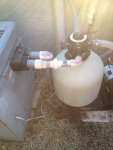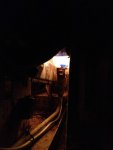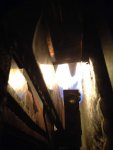The six way valve on my sand filter is deformed and leaking. I think the pilot light on my pool heater is heating the water enough to melt the valve. Is this possible?
I recently added a timer to the pump. This includes a fireman's switch.
I have the timer set to run from 7am to noon, and 5pm to 10pm.
Everything seems to be working properly.
The heater comes on after the pump is running, and only when the pump is running.
The heater turns off when the pool reaches the proper temperature.
The fireman's switch turns the heater off about 20 minutes before the pump turns off.
The pipe from the filter to the heater is cool to the touch when the pump is running, whether the heater is on or off.
The hose from the heater back to the pool is warm, but not hot, when the pump and heater are both running. It is cool when the heater is off and the pump is running.
Hours after the heater and pump have been off, both the pipe to the heater and the hose from the heater get really hot. Not soon after the pump is off, but hours after the heater and pump have been off.
The six way valve started leaking out of the waste line. I took it apart and found the inside features melted and deformed.
Where is all this heat coming from?
Am I supposed to be able to use a timer with my setup?
I have purchased a new valve, but I am afraid to even have the pilot lit on the heater without the pump running full time.
What am I doing wrong?
Thanks for any advice.
I recently added a timer to the pump. This includes a fireman's switch.
I have the timer set to run from 7am to noon, and 5pm to 10pm.
Everything seems to be working properly.
The heater comes on after the pump is running, and only when the pump is running.
The heater turns off when the pool reaches the proper temperature.
The fireman's switch turns the heater off about 20 minutes before the pump turns off.
The pipe from the filter to the heater is cool to the touch when the pump is running, whether the heater is on or off.
The hose from the heater back to the pool is warm, but not hot, when the pump and heater are both running. It is cool when the heater is off and the pump is running.
Hours after the heater and pump have been off, both the pipe to the heater and the hose from the heater get really hot. Not soon after the pump is off, but hours after the heater and pump have been off.
The six way valve started leaking out of the waste line. I took it apart and found the inside features melted and deformed.
Where is all this heat coming from?
Am I supposed to be able to use a timer with my setup?
I have purchased a new valve, but I am afraid to even have the pilot lit on the heater without the pump running full time.
What am I doing wrong?
Thanks for any advice.





